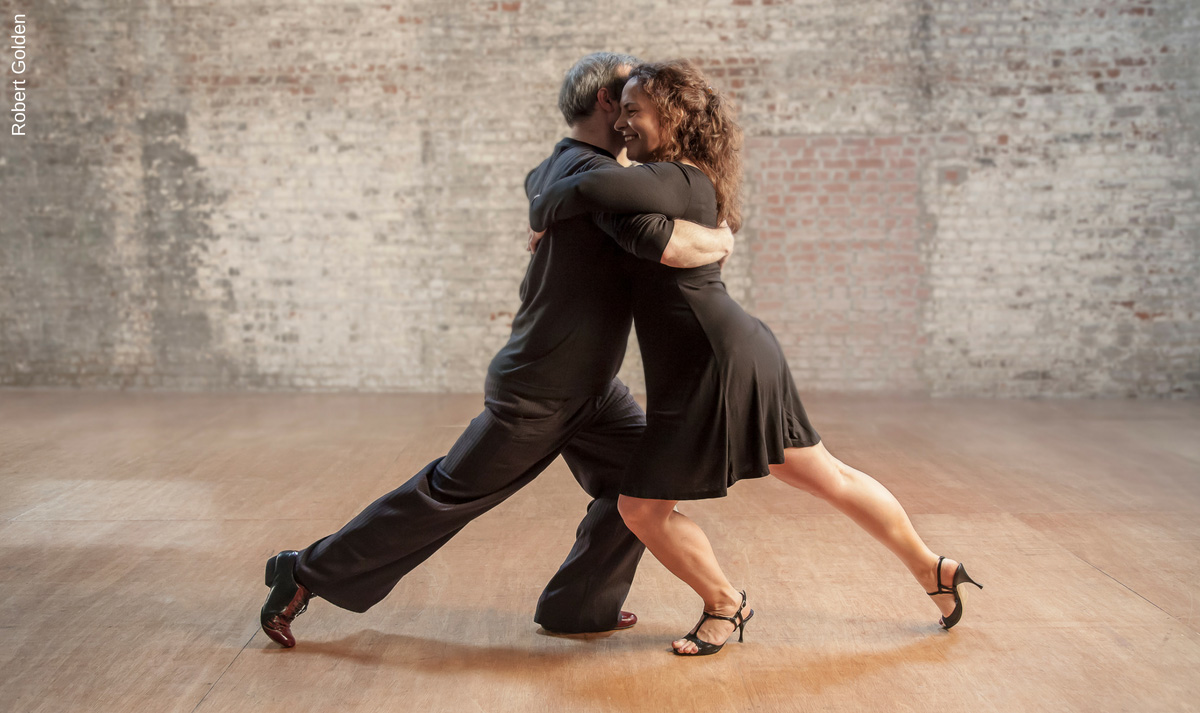by Donna Gianell
“Dance is the one expression involving the faculties on all levels: spiritual, intellectual and physical.” – Plato
“When you take a step, rise, and fall like in breathing.
“Lengthen when you step out, and soften the knees and lower the body when the feet come together. You do the same thing when stepping to the side, and then bringing the other foot next to it.
“Don’t hurry it. Sense it, feel it, breathe with it, be with it.”
These are the instructions I heard when learning the art form called Tango. Sounds a lot like a Feldenkrais® Awareness Through Movement® class, doesn’t it?
Tango as a way of Life
“For us, the tango is a way of living – a way of feeling and a way of thinking,” said native Argentinian tango teacher Danel Bastone. Teaching in the US since the 60s with his wife, Maria, they coached Madonna for her role in the movie Evita. My husband, Ken, and I took lessons from the Bastones, among others, in the early ‘90s. We were running a magazine called “Dance & the Arts” at the time. Because it covered dance teachers, dance shows, and movies, we were able to learn with dancers in Broadway shows like “Argentine Tango” and “Forever Tango.” We even learned from the male lead in the movie The Tango Lesson, Pablo Vernon.
Beyond running a magazine, Ken and I were also a professional dance team. We studied the Argentine Tango in order to incorporate it into our choreographed routines. At the time, I was a “no pain, no gain” kind of person. I’d been hit by a car years earlier, resulting in being in a state of continual pain. I coped through denial: I didn’t like listening to my body because it kept talking about pain. Then, I started taking Awareness Through Movement classes at the West Side YMCA in NY. (I’ve now been teaching there since 2003.) It took about a year before I realized that true graceful and coordinated movement wasn’t about pushing, forcing, or stretching the body to the maximum. It was about listening to my body instead of telling it – dictating to it – what to do. After I realized that, a true healing of my body began and then translated to other aspects of my life – like Tango.
“The tango is not a dance – it is a feeling.” – Tango legend Carlos Gavito
When learning from the Bastones, as well as other Argentinian teachers like Alicia Crusada and Karina Romero, we’d practice walking forward and backward, stepping and tapping from side-to-side with an emphasis on the shifting of weight, staying on top of the hips, and lengthening and lowering. “Lengthening and lowering” is essential for leading and following. When dancing with a partner, the intention is to listen to each other and have a conversation – a request, acknowledgment, response. Sometimes the follower closed their eyes while being led. Both had to listen and not assume. (Hmm, more hints of the Feldenkrais Method®!) If the follower assumed, but the leader did something different, it wouldn’t work. If the leader moved too quickly or was indecisive, the follower was lost. The leader is supposed to wait and make sure that he/she is communicating clearly. So it comes down to listening, feeling (sensing) and relationship. (Much later I learned that walking backward is beneficial in helping those with Parkinson’s, dementia, and Alzheimer’s Disease.)
Integrating the Feldenkrais Method into Tango Classes
After becoming a Feldenkrais practitioner, I began applying Feldenkrais Method concepts into the classes I taught. During Tango class, my students would explore the feeling of individually shifting weight from one foot to another in place slowly, then with a partner and to music. When the music was added, they lit up; everything is vibration and frequency. When the lilting vibrations of those tango strings and other musical instruments permeate throughout your body nourishing and massaging it, your whole being responds.
Because I learned to teach by having my students slowing integrate new movements, neither age nor ability impedes learning the Tango! I have students of all ages and various walks-of-life, including senior citizens and those with limited mobility in my classes who have discovered that applying a Feldenkrais perspective on learning Tango can be an empowering experience that improves their posture and balances their overall strength.
Moving together as one is a magical way of discovering yourself as well as the partner with whom you are dancing. The exhilaration of sensing yourself as you effortlessly glide through space is a personal, empowering and transformational experience. And let’s not forget about the passion. It’s intoxicating. These are all different kinds of relationships. Hopefully, you will enjoy all your relationships as you dance through life.
 Donna Gianell experienced her first ballet class aged four. She has since added many different kinds of dance to her repertoire. Teaching and performing was her life even after suffering injuries from a hit-and-run accident. She was dancing in pain until she found the Feldenkrais Method in 1996. She’s taught Awareness Through Movement lessons for 16 years at an NYC YMCA, as well as at the 2013 New York Feldenkrais Conference. She teaches tango to people of all ages and abilities. bodymindfreedom.org
Donna Gianell experienced her first ballet class aged four. She has since added many different kinds of dance to her repertoire. Teaching and performing was her life even after suffering injuries from a hit-and-run accident. She was dancing in pain until she found the Feldenkrais Method in 1996. She’s taught Awareness Through Movement lessons for 16 years at an NYC YMCA, as well as at the 2013 New York Feldenkrais Conference. She teaches tango to people of all ages and abilities. bodymindfreedom.org

